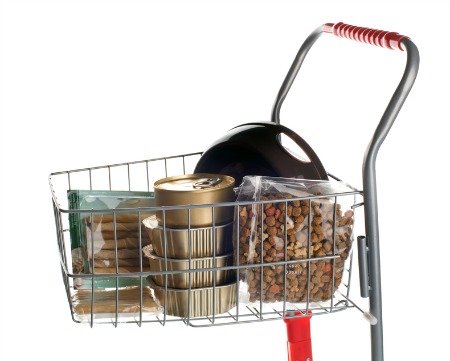Dog treat storage, when done properly, will keep your home-made dog treats fresh and free from mold, insects and other creatures.
Dry dog food storage and dog treat storage are very similar. They both require the same conditions to keep them fresh.

Storing your homemade dog treats and dog food in a dark, dry environment is the first step to keeping them fresh.
This is especially important, if you live in a humid environment–whether you live in the woods, the mountains, by a stream or close to the ocean.
If you live where it’s humid, you’ve probably already discovered ways to keep crackers, bread and snack foods fresh.
The principles for keeping dog treats fresh, are the same.
Where to Store Homemade Dog Treats
There are three choices for storing your homemade dog treats: in a dog food storage container or cookie jar at room temperature, in the refrigerator, and in the freezer.
Depending on the kind of dog treats, and how long you need to keep them, you will need to make a choice about how to store them.
Why is this important? Proper storage of your dog biscuits will prevent the growth of mold and spoilage of your treats. Dry dog treats do not support the growth of mold and bacteria. Moist ones do…
Safe Dog Treat Storage
If you bake for your dog, you are probably using natural, healthy ingredients. Baking healthy homemade dog treats means that you are probably using healthy natural whole grains and oils in your homemade dog biscuits and cookies.
That’s great! But there is a downside to using natural ingredients. They don’t stay “fresh” as long as store bought treats that have chemical preservatives.
Because they contain healthy live food, natural ingredients can support the growth of mold, they can decompose, and otherwise healthy oils can become rancid.
So what can you do to preserve the freshness of your homemade dog treats?
Dry the Treats Properly
This is the most important thing that you can do! Drying your dog treats (or dehydrating them) is really quite simple.
Make sure you bake them until they are getting firm to the touch, but not over browned or burned. I like to transfer the treats, at this point, into a clean Corningware glass dish. I then turn the oven off, and let the treats finish drying in the oven, overnight.
In the morning, check the treats to make sure that they are hard and very dry. If they have any “give” to them, leave them in the oven, heat it to 350 degrees, and then turn it off. Leave the treats in the oven until they are thoroughly dry.
Use a Dehydrator
If you have a food dehydrator, you can use it to dry your treats. Follow the manufacturer’s directions for the dehydrator, and check frequently to see if the treats are hard and dry.
You can use a dehydrator to finish drying the dog treats or you can use it exclusively to “bake” them.
Use a Natural Preservative
While chemical preservatives can be bad for your dog (and for you), natural food preservatives can extend the shelf life of your homemade dog treats, safely.
Especially if you have a dog bakery business, you should consider using a small amount of a natural preservative so your homemade dog treats will resist mold and stay fresh.
Soft Dog Treats and Dog Cakes
Soft dog treats, dog cakes and dog muffins should be stored in the refrigerator or freezer to keep them fresh, as they do contain moisture.
Dog Food Storage Containers
Your choice of a dog treat storage container is also important. A cute cookie jar or dog treat canister works well for everyday storage of dry dog treats, as long as it is fairly air-tight.
It’s also important to choose a good storage canister for your dog treats. A cute dog treat jar or dog treat canister is fine in most homes with normal levels of humidity. Most have a fairly tight seal. And there are so many decorative ones that it will be hard to choose the best one!
Additionally, you might want to consider using airtight dog food storage containers for large amounts of dog food or extra dog treats.
Properly stored dry dog treats should stay fresh for up to a year. However, dog treats with a lot of oil or peanut butter, should be refrigerated to prevent rancidity, if you intend to store them for more than 3 or 4 months.


